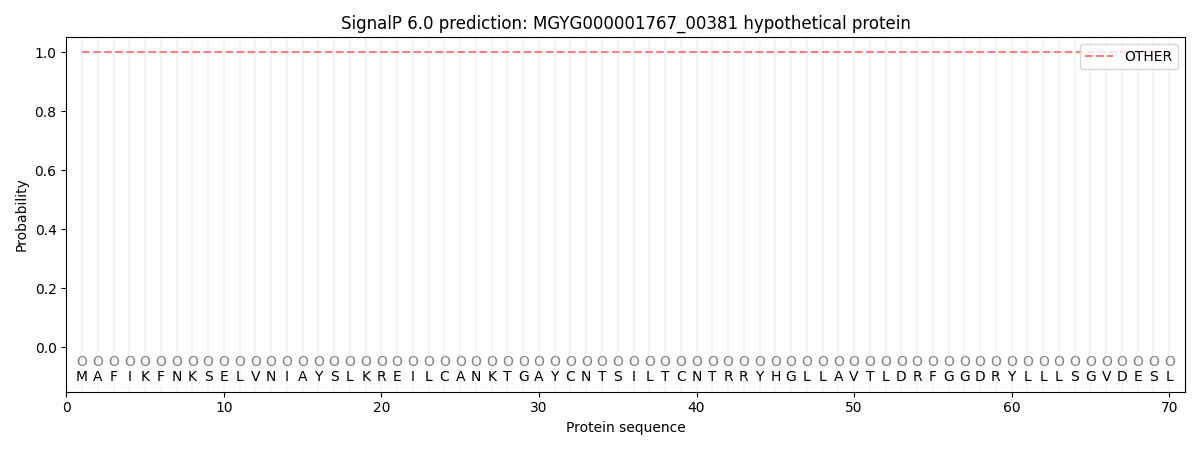You are browsing environment: HUMAN GUT
CAZyme Information: MGYG000001767_00381
You are here: Home > Sequence: MGYG000001767_00381
Basic Information |
Genomic context |
Full Sequence |
Enzyme annotations |
CAZy signature domains |
CDD domains |
CAZyme hits |
PDB hits |
Swiss-Prot hits |
SignalP and Lipop annotations |
TMHMM annotations
Basic Information help
| Species | RC9 sp000432655 | |||||||||||
|---|---|---|---|---|---|---|---|---|---|---|---|---|
| Lineage | Bacteria; Bacteroidota; Bacteroidia; Bacteroidales; UBA932; RC9; RC9 sp000432655 | |||||||||||
| CAZyme ID | MGYG000001767_00381 | |||||||||||
| CAZy Family | GH133 | |||||||||||
| CAZyme Description | hypothetical protein | |||||||||||
| CAZyme Property |
|
|||||||||||
| Genome Property |
|
|||||||||||
| Gene Location | Start: 70776; End: 72719 Strand: - | |||||||||||
CAZyme Signature Domains help
| Family | Start | End | Evalue | family coverage |
|---|---|---|---|---|
| GH133 | 288 | 633 | 2.4e-69 | 0.9731182795698925 |
CDD Domains download full data without filtering help
| Cdd ID | Domain | E-Value | qStart | qEnd | sStart | sEnd | Domain Description |
|---|---|---|---|---|---|---|---|
| TIGR01561 | gde_arch | 1.62e-77 | 21 | 577 | 1 | 575 | glycogen debranching enzyme, archaeal type, putative. The seed for this model is composed of two uncharacterized archaeal proteins from Methanosarcina acetivorans and Sulfolobus solfataricus. Trusted cutoff is set so that essentially only archaeal members hit the model. The notable exceptions to archaeal membership are the Gram positive Clostridium perfringens which scores much better than some other archaea and the Cyanobacterium Nostoc sp. which scores just above the trusted cutoff. Noise cutoff is set to exclude the characterized eukaryotic glycogen debranching enzyme in S. cerevisiae. These cutoffs leave the prokaryotes Porphyromonas gingivalis and Deinococcus radiodurans below trusted but above noise. Multiple alignments including these last two species exhibit sequence divergence which may suggest a subtly different function for these prokaryotic proteins. [Energy metabolism, Biosynthesis and degradation of polysaccharides] |
| pfam12439 | GDE_N | 4.57e-77 | 20 | 241 | 1 | 209 | Glycogen debranching enzyme N terminal. This domain family is found in bacteria and archaea, and is typically between 218 and 229 amino acids in length. The family is found in association with pfam06202. Glycogen debranching enzyme catalyzes the debranching of amylopectin in glycogen. This is done by transferring three glucose subunits of glycogen from one parallel chain to another. This has the effect of enabling the glucose residues to become more accessible for glycolysis. |
| pfam06202 | GDE_C | 7.57e-70 | 284 | 633 | 13 | 373 | Amylo-alpha-1,6-glucosidase. This family includes human glycogen branching enzyme AGL. This enzyme contains a number of distinct catalytic activities. It has been shown for the yeast homolog GDB1 that mutations in this region disrupt the enzymes Amylo-alpha-1,6-glucosidase (EC:3.2.1.33). |
| COG3408 | GDB1 | 5.60e-47 | 18 | 633 | 3 | 600 | Glycogen debranching enzyme (alpha-1,6-glucosidase) [Carbohydrate transport and metabolism]. |
| PRK00984 | truD | 7.65e-04 | 314 | 411 | 227 | 320 | tRNA pseudouridine synthase D; Reviewed |
CAZyme Hits help
| Hit ID | E-Value | Query Start | Query End | Hit Start | Hit End |
|---|---|---|---|---|---|
| QKG79282.1 | 3.41e-195 | 1 | 642 | 1 | 645 |
| SNV25936.1 | 2.96e-191 | 1 | 647 | 1 | 651 |
| QRO49261.1 | 2.45e-189 | 1 | 642 | 1 | 646 |
| AZS31821.1 | 3.83e-189 | 1 | 645 | 1 | 649 |
| QIK55660.1 | 4.01e-181 | 1 | 647 | 1 | 652 |
Swiss-Prot Hits help
SignalP and Lipop Annotations help
This protein is predicted as OTHER

| Other | SP_Sec_SPI | LIPO_Sec_SPII | TAT_Tat_SPI | TATLIP_Sec_SPII | PILIN_Sec_SPIII |
|---|---|---|---|---|---|
| 1.000034 | 0.000001 | 0.000000 | 0.000000 | 0.000000 | 0.000000 |
